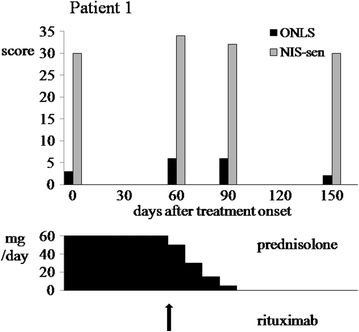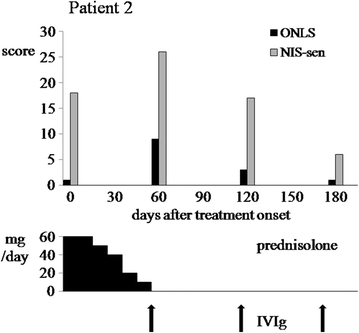Pure sensory chronic inflammatory polyneuropathy: rapid deterioration after steroid treatment
- PMID: 25885891
- PMCID: PMC4359520
- DOI: 10.1186/s12883-015-0291-7
Pure sensory chronic inflammatory polyneuropathy: rapid deterioration after steroid treatment
Abstract
Background: Chronic inflammatory demyelinating polyneuropathy (CIDP) as a pure sensory variant is rarely encountered. Therefore the best treatment option is hard to define.
Case presentations: We reported two middle-aged patients of Caucasian origin, one female and one male, who over a period of several months presented limbs and gait ataxia. Clinical and neurophysiological examination revealed only sensory abnormalities. A diagnosis of atypical CIDP was suggested, considering the elevated CSF protein level and the presence of anti-gangliosides antibodies. Ten and 15 days respectively after initiation of prednisolone treatment both patients experienced exacerbation of sensory symptoms and emerging of muscle weakness. Steroids were then substituted by rituximab in the first patient and intravenous immunoglobulin in the second patient resulting in gradual decrement of symptoms and signs. Two-year follow-up showed no further deterioration.
Conclusion: Caution should be exercised when treating cases of pure sensory polyneuropathy with high dose steroids since an unfavorable outcome is possible.
Figures
References
-
- Notermans NC, Wokke JH, Franssen H, van Der Graaf Y, Vermeulen M, van Den Berg LH, et al. Chronic idiopathic polyneuropathy presenting in middle or old age: a clinical and electrophysiological study of 75 patients. Journal of Neurol Neurosurg Psychiatry. 1993;56:1066–71. doi: 10.1136/jnnp.56.10.1066. - DOI - PMC - PubMed
Publication types
MeSH terms
Substances
LinkOut - more resources
Full Text Sources
Other Literature Sources
Medical



